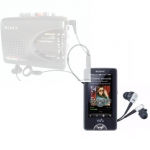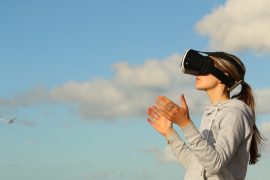Consumer Tech for March: Where the iPod and iPad really Came from
By Richard M. Sherwin, Robert Plunkett and the staff of Digital Family Advisor
How Dell, HP and others missed the tablet boat.
Around 20 years ago, in a cafe about two blocks from one of the biggest newspapers in the country, two feature reporters with very little tech savvy were peering through clouds of cigar and cigarette smoke when a PR lady from Compaq Computer, a slightly eccentric looking engineer scientist from Sony and a local disk jockey from a popular radio station came sashaying into the semi private meeting room in the back of the bar.
They showed us a device the size of a transistor radio, perhaps a little bigger, that was playing what seemed like prerecorded top 40 hits. But there was no tape and the device was very light weight, almost as if there was nothing inside. The device had an AM-FM radio and, while the sound of the radio was 60ish tinny, the audio from the recorded music coming from the device was as clear as a concert hall.
 The meeting was going on for about 20 minutes when the Compaq, Sony people and disk jockey excused themselves because the device ran out of battery life. They went across the street to the automat where they could try and charge the device. When they returned about a half hour later, the little radio-music player also started to sound like an ice maker. The Sony person, who we thought we might have met during the launch of the best selling Sony Walkman, said that like it or not, within two years, we’d be hearing music not from a tape or a disc but from RAM (Random Access Memory). He also claimed that the strange sounding device we were holding would produce a so called digital music sound that would rival the feeling you got from a concert hall, intimate jazz room or even giant outdoor stadium. He was right. But Sony and Compaq (later sold to HP) never got to manufacturer a digital audio player. And even though six months after this meeting, the first digital audio format called MP3 was publicly released, it would take another ten years before the iPod and other MP3 players became popular.
The meeting was going on for about 20 minutes when the Compaq, Sony people and disk jockey excused themselves because the device ran out of battery life. They went across the street to the automat where they could try and charge the device. When they returned about a half hour later, the little radio-music player also started to sound like an ice maker. The Sony person, who we thought we might have met during the launch of the best selling Sony Walkman, said that like it or not, within two years, we’d be hearing music not from a tape or a disc but from RAM (Random Access Memory). He also claimed that the strange sounding device we were holding would produce a so called digital music sound that would rival the feeling you got from a concert hall, intimate jazz room or even giant outdoor stadium. He was right. But Sony and Compaq (later sold to HP) never got to manufacturer a digital audio player. And even though six months after this meeting, the first digital audio format called MP3 was publicly released, it would take another ten years before the iPod and other MP3 players became popular.
Apple’s iPod, in our opinions not even the third best MP3 or multimedia player on the market, has, nevertheless, 85% of the market. Why are we mentioning this? Because some companies never learn. The iPad Tablet momentarily has the lead in its category, but five years ago, HP-Compaq, Sony and even Dell had tablet computers ready to launch, and they blew it again. Ironically, the company that makes the iPad in Asia is the same one that made the Dell, and HP Tablets five years ago.
This time we were smart enough to at least ask Dell, HP-Compaq and a few others who toyed with a tablet five years ago, why they abandoned the market. Spokespersons at those companies wouldn’t talk on the record, but did reveal some reasons.
A slightly disgruntled sales exec with one of those companies told DFA a few weeks ago, “We were sure that the power, speed and size of our Netbook computers would outstrip the demand for a Tablet,” said a source at HP. “Our product marketing people were at loggerheads with sales people because even the low priced Netbooks we were planning had a better margin than the Tablets,” said a source at Dell. “Our version of the iPad was turned down as too gimmicky, says a Sony executive.
And finally, when Digital Family Advisor reached some of the OEMs (Original Equipment Manufacturers) in Asia they indicated that no one ever though Apple would sell these tablets for more than $250, no less get almost three times the costs of the units in its final price to the public.
Unusual and Usual Home Electronics Products that Really Work
Between the recent toy fair in NYC, the mobile show in Spain and a dozen or so other product launches from big and small companies, some products that came to our review process lately might be thought of as not so serious devices because our staff that believes anything that doesn’t’ have a jillion Hz processor or 3D super speed WIFI or let’s you watch videos on your watch, is just a toy.
But some of us beg to differ. Here are a few items that some of us really love. They might make your life mellower without breaking your bank account or even requiring a dozen batteries. (We’ve also added some that might break your bank account or require the fastest internet access or a dozen batteries…otherwise we wouldn’t be DFA.)
Because the DFA staff is located in many time zones and sometimes different continents, and we need to sometimes talk live to each other, sleep is something that becomes troublesome. The NightWave Sleep Assistant, a more effective and cheaper alternative to sound machines, is a 100% natural solution that uses your body’s relaxation response to solve problems falling asleep. And since it only requires one little 9 volt battery (included), and you are not ingesting any kind of pill, it’s a safe and easy thing to try out. Now don’t laugh because this is how it works: NightWave projects a soft blue light into your darkened bedroom. The “luminance” of the light slowly rises and falls. You lie with eyes open and synchronize your breathing with the wave of soft light as its movement becomes slower and slower. After a short time, NightWave shuts off and you roll over and fall asleep. And unlike sound machines, the soft light does not disturb others. The $69 device comes with a 30 day money back guarantee. www.nightwave.com.
The Sound Oasis Sleep Therapy Pillow SP-150 is another sleep aid. It reminds us of the first portable radio that we used to hide under our blanket and or pillow as a kid. The SP-150 allows users to enjoy their favorite music or sounds in optimal relaxation and comfort. With two high fidelity, ultra-thin stereo speakers positioned deep within the pillow, users can surround their head with sound for enhanced therapy or privacy. The SP-150 is 20″ x 26″ (51 cm x 66 cm), with a soft brushed cover and hypoallergenic polyester fiberfill, is an excellent every day pillow. With patent pending technology, the Sleep Therapy Pillow can be machine or hand washed by easily removing the speakers. The $65 product is available at most retail and drug stores now and, so far at DFA, we are split between using new age relaxing Windham Hill music on our easily attached MP3 player…while kids of all ages might be using this to have west coast sports events help them go to sleep or maybe some Bach for the older sleepers.
While we love our DXG Waterproof camcorder, for thousands of consumer who live with their Flip camcorders, we found the Aquapac Waterproof Case, which can allow you to use the famous camcorder in more places and for many more activities than you ever thought possible. With the Aquapac Waterproof Case, you can safely take video during all your favorite activities: kayaking, skiing, snowboarding, biking, hiking and even snorkeling. It’s about $29 at many locations and online.

